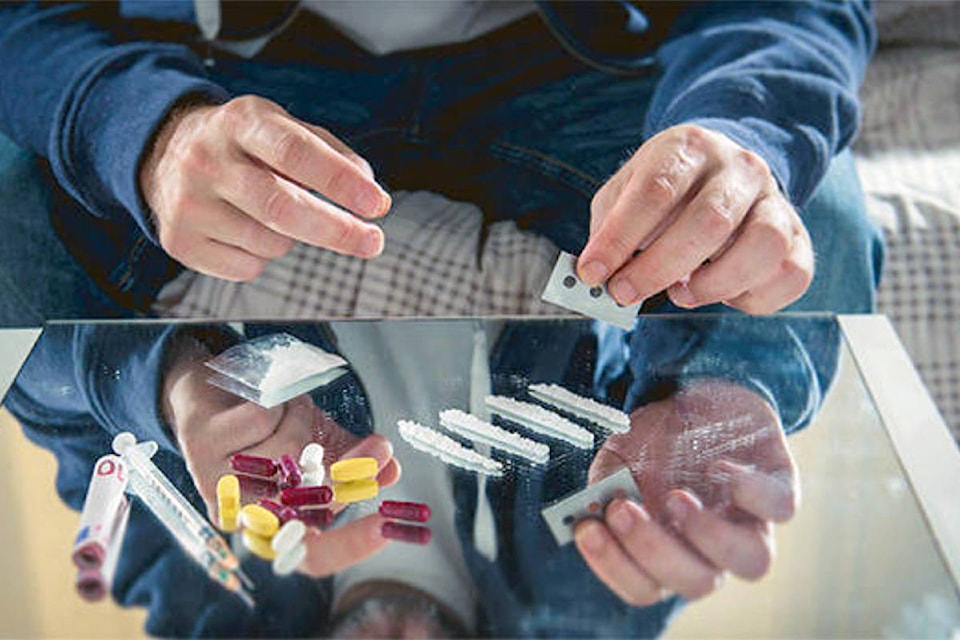About three years ago, in April 2016, British Columbia responded to the opioid crisis by declaring it a public health emergency.
Prior to 2016, about 200-400 people were dying per year in B.C. due to illicit drug overdoses. In 2016, this number jumped to more than 1,000. The province responded by taking steps like distributing naloxone kits, an overdose-reversal medication, across the province, increasing treatment options and, in some places, expanding or adding safe injection sites.
Vernon Medical Health Officer Dr. Karin Goodison explained the B.C. Interior was — and is — no stranger to this crisis. She said that the first places in the area to experience high number of overdoses were Kelowna and Kamloops. But, more recently, overdose death rates have drastically increased in both Vernon and Penticton.
“I think it’s safe to say that Vernon, Kamloops and Kelowna all have overdose death rates higher than that of the B.C. average,” she said. “In 2018, Vernon had an overdose death rate greater than seen in all of the Interior overall.”
A topic of contention among Vernon residents, Goodison noted that stigma plays a significant role in people’s ability to access services in a safe way; the ultimate goal being treatment and recovery.
“I think it’s healthy for us all to reflect on how things that happened in our lives — whether that’s an injury or a traumatic event — and how that could have changed our life course,” said Goodison. “People don’t wake up and suddenly decide to become addicts.”
She said she is hoping to appeal to the public, humanize the problem and help end the stigma associated with addiction in an effort to help people seek treatment and reduce the number of opioid-related deaths in the B.C. Interior.
Related: First Nation chiefs call for B.C. to declare state of emergency over opioid crisis
Related: Overdose deaths down 30% so far in 2019, B.C. officials ‘cautiously optimistic’
Vernon residents Jocelyn* and James* are living examples. Though you probably wouldn’t have guessed it today, both have experienced a complicated history with addiction.
Jocelyn said she was just 13-years-old when she began using alcohol and drugs recreationally. Today, at 33, she said that she now realizes that by the time she was 17, she was an alcoholic.
“I’ve been through a lot of trauma in my life and in order to cope with those traumas, my go-to was drinking and using drugs,” she said, noting that though her drug of choice was cocaine, before seeking treatment at Bill’s Place, she was using a variety of substances.
She said she had experienced trauma as a child and endured several abusive relationships. She also had three children and suffered a significant loss when their father suddenly died.
“I couldn’t cope or deal with the pain and began drinking and using drugs everyday. My kids were removed about three weeks after his death and for two years, I was a mess,” she said. “I lost my car, my kids, I got kicked out of school and my life just spiralled out of control.”
She decided to seek treatment and take a two-week course through the Vernon Treatment Centre about 20 months ago. But, she said she wasn’t ready to get sober and relapsed several times. It took her three attempts to finally compete the course.
“But that’s addiction,” she said. “It just takes control of your life.”
After a long waiting period, she was accepted into Bill’s Place in November 2018 and has been sober for eight months. Her children were returned to her at the end of June.
James’ story is somewhat similar. He became a father at 15 but eventually moved to Vernon, away from his child and her mother. With less responsibility, he said he started partying; using drugs and alcohol more consistently.
He had two more kids in his mid-20s, began his own business and bought a house.
“I was doing really well for a while but then started drinking and using cocaine every day and the mother of my children wasn’t happy with that so she left. I didn’t know how to cope with that so I started smoking crack and eventually lost my house, my family, everything.”
He sought treatment but soon relapsed.
“I didn’t really deal with anything. That’s where the manipulation came into play because I could just fool everybody by going to work and putting on a show but I was using drugs a lot.”
Then, in 2010, he broke his ankle and needed surgery. He was given morphine for pain.
“I fell in love with [morphine] but then they cut me off of the pills and so I started using heroin. I was a heroin addict for probably eight years with stints of sobriety,” he said. “I always worked and I always had lots of money but I was a really bad heroin addict and then I started using meth with it and just went crazy.”
He said that in a span of three years, he overdosed over 20 times. He hit bottom after physically injuring people with a metal pipe while in a state of psychosis, which landed him in jail (though charges were eventually dropped). After his release, his girlfriend brought him to the hospital.
He went through detox and was accepted into Bill’s Place in 2016. He has been sober ever since.
Editor’s Note: Names* have been changed for anonymity and safety purposes. Part two of this series will address statistics and findings regarding the opioid crisis within the B.C. Interior.
Related: B.C.’s opioid crisis leads to first stall in Canadian life expectancy in 40 years: study
Related: Number of homeless deaths more than doubled in B.C. as opioid crisis set in
To report a typo, email:
newstips@vernonmorningstar.com.
Follow me on Twitter @BrieChar
Email me brieanna.charlebois@vernonmorningstar.com
Like us on Facebook.
